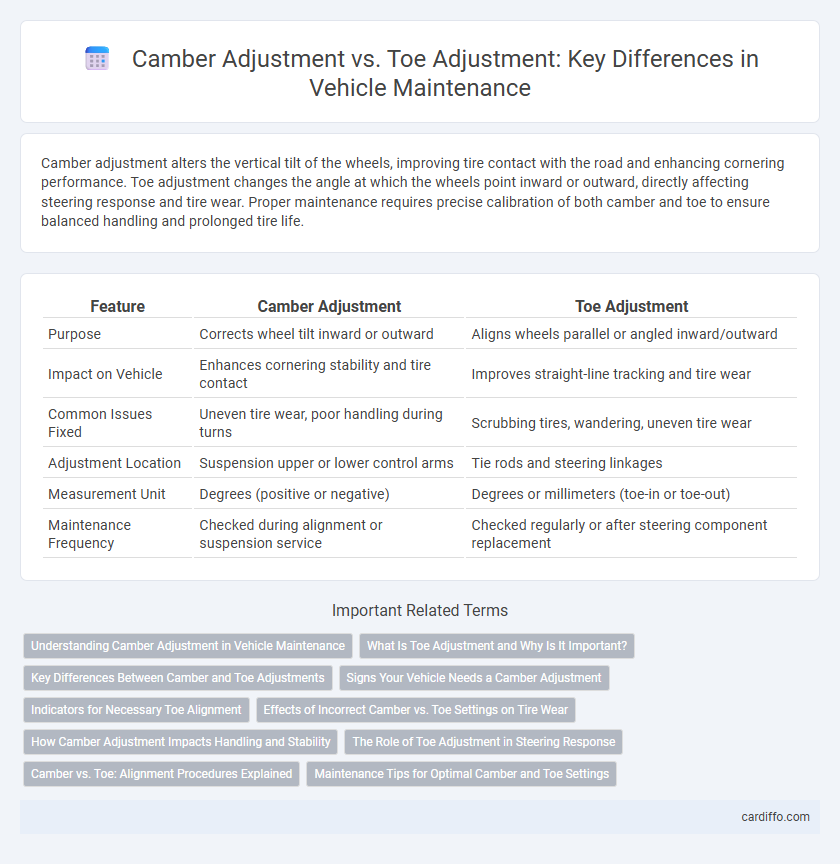Camber adjustment alters the vertical tilt of the wheels, improving tire contact with the road and enhancing cornering performance. Toe adjustment changes the angle at which the wheels point inward or outward, directly affecting steering response and tire wear. Proper maintenance requires precise calibration of both camber and toe to ensure balanced handling and prolonged tire life.
Table of Comparison
| Feature | Camber Adjustment | Toe Adjustment |
|---|---|---|
| Purpose | Corrects wheel tilt inward or outward | Aligns wheels parallel or angled inward/outward |
| Impact on Vehicle | Enhances cornering stability and tire contact | Improves straight-line tracking and tire wear |
| Common Issues Fixed | Uneven tire wear, poor handling during turns | Scrubbing tires, wandering, uneven tire wear |
| Adjustment Location | Suspension upper or lower control arms | Tie rods and steering linkages |
| Measurement Unit | Degrees (positive or negative) | Degrees or millimeters (toe-in or toe-out) |
| Maintenance Frequency | Checked during alignment or suspension service | Checked regularly or after steering component replacement |
Understanding Camber Adjustment in Vehicle Maintenance
Camber adjustment in vehicle maintenance involves altering the angle of the wheels relative to the vertical axis to optimize tire contact and improve handling performance. Proper camber settings reduce uneven tire wear, enhance cornering stability, and maintain suspension alignment for better overall driving safety. Unlike toe adjustment, which focuses on wheel direction parallelism, camber adjustment primarily targets vertical tilt to balance traction and prevent premature tire degradation.
What Is Toe Adjustment and Why Is It Important?
Toe adjustment refers to the alignment of a vehicle's front or rear wheels in relation to each other, measured by the angle at which they point inward (toe-in) or outward (toe-out). Proper toe adjustment ensures optimal tire contact with the road, enhancing handling, reducing tire wear, and improving fuel efficiency. Neglecting toe alignment can lead to uneven tire wear, unstable steering, and compromised vehicle safety.
Key Differences Between Camber and Toe Adjustments
Camber adjustment alters the vertical tilt of the wheels, impacting tire contact with the road and overall handling, while toe adjustment modifies the angle of the wheels relative to the vehicle's centerline, affecting steering response and tire wear. Camber changes primarily influence cornering performance and stability, whereas toe adjustments enhance straight-line tracking and reduce uneven tire degradation. Precision in camber and toe alignment is essential for optimal vehicle safety, tire longevity, and fuel efficiency.
Signs Your Vehicle Needs a Camber Adjustment
Uneven tire wear, especially excessive wear on the inner or outer edges of the tires, indicates a possible camber misalignment requiring adjustment. Noticeable pulling of the vehicle to one side while driving or steering instability also signals that the camber angle may be off. If your vehicle's suspension shows signs of uneven stress or you experience reduced handling performance, a camber adjustment is necessary to restore proper alignment and tire contact.
Indicators for Necessary Toe Alignment
Uneven tire wear, especially feathering or scalloping on the edges, serves as a primary indicator for necessary toe alignment adjustments. Vehicle pulling to one side and noticeable steering wheel vibration during driving also signal misaligned toe settings. Regular inspection of these symptoms ensures timely maintenance, preventing premature tire damage and enhancing overall vehicle stability.
Effects of Incorrect Camber vs. Toe Settings on Tire Wear
Incorrect camber settings cause uneven tire wear primarily on the inner or outer edges, leading to premature edge degradation and compromised vehicle handling. Improper toe adjustment results in feathered tire tread patterns due to excessive scrubbing, significantly reducing tire lifespan and fuel efficiency. Both misalignments increase tire replacement frequency and negatively impact overall suspension performance.
How Camber Adjustment Impacts Handling and Stability
Camber adjustment directly influences vehicle handling by altering the tire's angle relative to the road, optimizing grip during cornering and reducing tire wear. Negative camber enhances stability and responsiveness on turns by increasing the contact patch of the tire's outer edge. Proper camber settings improve overall handling balance, especially in performance and racing applications, while improper adjustments can lead to uneven tire wear and decreased straight-line stability.
The Role of Toe Adjustment in Steering Response
Toe adjustment plays a crucial role in enhancing steering response by aligning the wheels to optimize contact with the road surface, which improves vehicle stability and handling precision. Precise toe settings reduce tire wear and contribute to smoother steering, making the vehicle more responsive during cornering and sudden maneuvers. Unlike camber adjustment that mainly influences vertical tire position, toe adjustment directly affects lateral wheel alignment and steering dynamics.
Camber vs. Toe: Alignment Procedures Explained
Camber adjustment involves tilting the wheels inward or outward to optimize tire contact with the road, improving corner handling and reducing uneven tire wear. Toe adjustment aligns the wheels parallel to each other, ensuring straight-line stability and preventing excessive tire scrubbing during movement. Precise camber and toe alignment are crucial in vehicle maintenance to enhance tire life, handling performance, and fuel efficiency.
Maintenance Tips for Optimal Camber and Toe Settings
Regularly inspect tire wear patterns to identify improper camber or toe alignment, as uneven wear indicates misalignment affecting vehicle handling and tire lifespan. Use precise alignment tools to adjust camber within the manufacturer's specified range, ensuring optimal tire contact and performance. Maintain correct toe settings by performing frequent alignment checks, preventing premature tire wear and enhancing steering responsiveness.
Camber Adjustment vs Toe Adjustment Infographic

 cardiffo.com
cardiffo.com